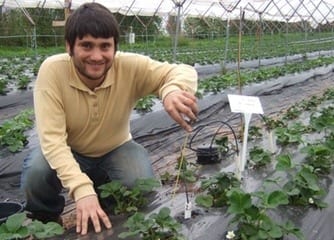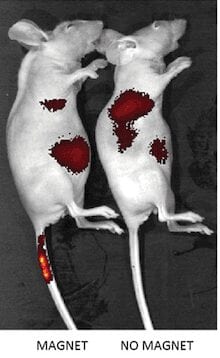
Thanks to a new app, smart phones could help monitor irrigation water use according to need.
This could ensure that food is available on our table is the produced in a sustainable way.
In Europe, irrigated agriculture is the chief water consumer for food production. Yet water resources are in limited supply. One way out of this problem is to take more care with the water we use, and reduce the estimated 60% water waste. Now, a phone app supplies farmers’ water thirsty crops with the right amounts of water at the right times, referred to in the field as irrigation scheduling.
An EU funded project, called WaterBee, is putting the system through its pace with a variety of crops in countries as far apart as Estonia, Italy, Spain and the UK. Its app gathers data remotely via sensors in the farmer’s field. The state of play is then crunched by maths equations, which relay back to the app how much water should be released by the sprinkler systems.
The problem is that inefficient water irrigation wastes a great deal of water. “About 70% of the water withdrawn from rivers and ground water by humans is for agriculture,”Andrew Thompson, a plant scientist at Cranfield University, UK, tells youris.com. He is working to save water using maths, technology and farming intelligence. The plan is to achieve water savings of 40% while improving crop quality too.
To do so, “the goal is to add just the right amount of water using mathematical models. Too much water and it is going to drain out from the soil; too little and your crop yields go down and you have problems with crop quality,” Thompson adds.
“The model divides up the soil into layers and then uses calculations for the transfer of water between layers,” Thompson says. It takes into account details of the soil, irrigation system, crop, roots and likely yields. The system makes irrigation recommendations based upon soil-moisture and weather data delivered via wireless technology to a computer server. It checks how well the simulated field matches reality and makes adjustments to bring the virtual closer to farm reality. “The main thing you need is mobile network coverage and it can work anywhere in the world really,” Thompson explains, who sees potential in Europe, South America and China in particular.
This is “not the first such system in terms of internet irrigation management data and tools, but it does appear that it also integrates system control, which tends to be the last piece of the puzzle,” Garry Grabo, tells youris.com, based on his expertise as an irrigation engineer at North Carolina State University, USA. He adds: “Systems such as these hold promise to apply emerging technologies for the purpose of more accurate irrigation scheduling. Additional benefits may include reduced irrigation, labour and energy savings.”
The Latest Bing News on:
Smart phone irrigation
- Exploring Next-Gen Home Automation with Full Spectrumon April 27, 2024 at 10:31 pm
Have you ever wished for a personal butler, similar to Alfred from the Batman series? Gone are the days when home automation was just a luxury; today, it has become a necessity- and one within your ...
- CropX now works with WiseConn smart irrigationon April 27, 2024 at 12:00 am
WiseConn smart irrigation users can now incorporate CropX Technologies’ digital farm management interface into their precision farming network. CropX’s data management system processes information ...
- How vagaries of climate change have pushed pastoralists of Isiolo County to crop farmingon April 26, 2024 at 5:00 pm
In 1971, the National Irrigation Board (NIB) constructed the main canal at Rapsu in Kinna, the county’s largest agro-pastoral zone. Farming proved difficult due to, among other things, insecurity ...
- Integrating Smart Home Technology in Modern Building Designon April 26, 2024 at 1:10 am
Introduction In Sydney, a hub for innovation and technology, integrating smart home technology in modern building designs reshapes how we live and interact with our environments. Infinite Building ...
- Outdoor HomeKit Gadgets: The MacStories Team Collectionon April 25, 2024 at 10:44 am
A couple of weeks ago, the MacStories team shared our favorite indoor HomeKit devices. The HomeKit accessory universe is more limited outdoors, but with spring easing into summer in the Northern ...
- Lumary Introduces Smart Sprinkler Water Timeron April 25, 2024 at 7:00 am
Lumary, a prominent player in the smart home industry known for its innovative indoor smart recessed lights, smart outdoor lighting solutions, and commercial lighting fixtures, proudly announces the ...
- Climate change may force irrigation on P.E.I. potato farmers, says researcheron April 24, 2024 at 4:51 am
Irrigation is relatively uncommon on P.E.I. farms, but that may have to change if Island farmers want to continue to grow potatoes, says Xander Wang, director of the Climate Smart Lab at UPEI.
- Artificial Intelligence, innovation and agricultureon April 23, 2024 at 6:20 pm
AI will impact every industry on Earth including agriculture…” - Fei Fei Li There is a town in Central Luzon where dozens of farmers depend solely on a single irrigation canal for their irrigation ...
- These Smart Devices Can Transform Your Gardenon April 18, 2024 at 5:00 pm
Even smart sprinkler systems have generally required ... from the different garden areas across your yard, and adjust your irrigation appropriately. Much like a robot vacuum surfs the ground ...
- Kenya’s Stable Foods on bolstering food security with irrigation tech: ‘The response from farmers has been encouraging’on April 18, 2024 at 9:36 am
Via an irrigation-as-a-service platform, Stable Foods tackles the prevalent challenge of food insecurity and poverty in East Africa.
The Latest Google Headlines on:
Smart phone irrigation
[google_news title=”” keyword=”smart phone irrigation” num_posts=”10″ blurb_length=”0″ show_thumb=”left”]
The Latest Bing News on:
Irrigation scheduling
- Oaklawn’s galloping tourist tradeon April 28, 2024 at 12:33 am
In April 2018, Oaklawn annnounced the most significant change in its racing schedule since World War II ... "So we built ponds and an irrigation system to keep the grass green. We created a park. We ...
- Davis: Time to audit your lawn irrigation systemon April 27, 2024 at 3:10 am
As we move out of winter weather and approach the summer months, now is a great time to give your lawn’s irrigation system an audit.
- How long does grass seed take to grow? We asked an experton April 27, 2024 at 12:30 am
If you’re wondering when your new grass will start to emerge, this is how long it takes grass seed to grow, according to an expert.
- CropX now works with WiseConn smart irrigationon April 27, 2024 at 12:00 am
WiseConn smart irrigation users can now incorporate CropX Technologies’ digital farm management interface into their precision farming network. CropX’s data management system processes information ...
- 8 Lawn Tasks You Need to Do in May — How to Treat Turf Now for Healthy Grass This Summer and Beyondon April 26, 2024 at 10:30 pm
'Rake the soil so it’s loose to 6 inches deep and amend the soil with compost and fertilizer, based on a soil test first,' says Charlie Nardozzi.'Keep newly seeded lawns and bare patches well watered ...
- County: Irrigation Schedule Begins May 1 And Runs Through Sept. 30on April 26, 2024 at 3:42 am
COUNTY NEWS RELEASE Community members who water outdoor spaces are reminded that the irrigation schedule under Water Rule W-8 will be in effect from May 1 through Sept.30. Falling under the rules ...
- City of Vero Beach sees significant decrease in water supply, urges residents to be vigilanton April 24, 2024 at 3:18 pm
"This time of year, we get very dry. And instead of just relying on their normal schedules, they’ll start turning their schedules and irrigating longer and more than they’re supposed to," Robert ...
- Thirsty Cities: How Collaborative Efforts Contribute To Water Conservationon April 22, 2024 at 4:16 am
The water storage in the major reservoirs and river basins in the country has dropped less than the average storage recorded in a decade for the corresponding period.
- Springtime Brings Landscape Construction And Irrigation Services From Denver Landscapers Like Sprinklers Evergreen And Landscapeon April 18, 2024 at 4:52 pm
As spring paints the Denver Metro area with vibrant hues and awakens the city with birdsong, homeowners turn their attention to revitalizing their outdoor havens. Sprinklers Evergreen and Landscape, ...
- Conservation Corner: Efficient irrigation systems are the unsung heroes of water conservationon April 16, 2024 at 6:59 am
You’ve likely read an article or two about turf removal and xeriscaping in the West, brought on by the aridification of our environment and an omnipresent drought. The message that less turf equals ...
The Latest Google Headlines on:
Irrigation scheduling
[google_news title=”” keyword=”Irrigation scheduling” num_posts=”10″ blurb_length=”0″ show_thumb=”left”]










